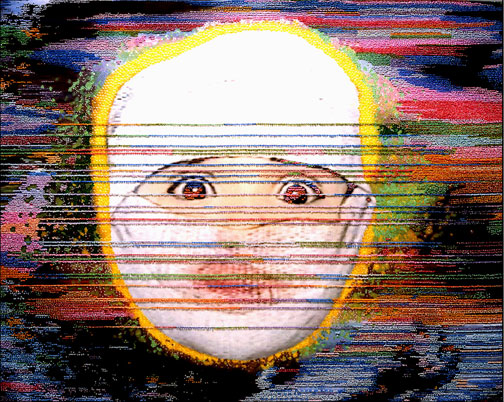


Patti
Heid:
Radioactive
April 14 -May 5, 2011
Reception Thursday April 14, 7-9pm
In conjunction with the downtown art walk

Airbrushed digital prints with hand sewn silk threads, feathers, beads,
Austrian crystals, sequins, pearls, and gold and silver bullion.
Patti Heid's works combine digitally composed photogaphic imagery with areas of acrylic airbrush as well as beads, sequins and gold bullion applied over large scale archival canvas prints. The semi-precious substances give the work an historical look of european tapestry and painting with incredible detail and sumptuous color.
Heid sews on the various elements by hand, and the craftsmanship required to do this adds a vast amount of personal expression to the canvases. She succeeds at combining the mechanical qualities of a digital print with the human touch of the artist. Each work then is one of a kind, and not reproducible, where the artist's hand becomes the carrier wave for a unique and imaginative narrative.
These enormous pieces are feminine and lyrical, containing imagery from nature and myth that make a pronouced move away from academia and the obviously technological, although they are clearly a product of the digital realm. The combination of disparate traditions and cultural referents is richly engaging with an often humorous, yet always beautiful effect. Each piece is literally a treasure, and are highly prized by critics and collectors alike.
In the Words of the Artist
PATTI HEID:
HATTITUDES
of FERTILE OPTIMISM
The mixed metaphor organic meets visual electronica, can be used
to describe these highly textured images that contrast with the rapidly
evolving, high tech, high speed world of technological advances and
accelerated chaos.
The introduction of beads painstakingly hand sewn with sequins, Austrian crystals, gold + silver bullion to the canvas brings an essence of humanity to the paintings. These tapestry like pieces are composed on video, manipulated and mutated to the desired image. The UV coated digital image on canvas has numerous layers of airbrushed acrylic paint to enhance the colors and personalize each painting before it is emblazoned with hand stitching.
Creating the fantastical hat imagery on innocents becomes a transport into the imagination. Using flowers as a symbol of sexual promise and spiritual purity, we are led to a classical garden of unearthly delights.
There
is an old maxim: the language of flowers is the language of love.
It is true not only in a metaphorical sense but also
in the sense of botanical biology. Flowers are the genitalia
of
plants. Flowers are used as messages, love charms, gifts
and ritual objects. The Greeks called the sunflower nymph Kleite,
derived from the root of the word clitoris. The orchid is named
from the
Greek word for a testicle, orchis. The red and white rose was
adopted by alchemists as a symbol of the vas spirituale, the
sacred womb from which the
filius philosophorunm, cosmos, would be born.
Flowers
still have extensive ceremonial uses as expressions of joy, affection,
welcome, gratitude, sympathy, celebration, grief, friendship,
marital union, or spiritual contemplation. Without even referring
to any formal language of flowers, people “say it with
flowers”.
The mercurial quality of water shaped into a hat explodes with
the robust exuberance of orgasm. The pagan ritual of eating
fish was
thought to be an aphrodisiac food in anticipation of sexual
rites honoring the goddess Venus (Aphrodite). From the traditions
associated
with the vesica piscis, a version of the fish sign, it is clear
that the fish was a female-genital symbol. In Egypt the fish
that swallowed
the penis of Osiris was thought the symbol of the vulva of
Isis, who was yet another incarnation of the primordial female
Deep.
The allegorical use of birds and bees, nature’s pollinators, is found here as a symbol of the male and feminine potency of nature. The hummingbirds’ act of penetrating the flower is extremely masculine. Demeter was “the pure mother bee” who governed the cycles of life. According to Porphyry, all bees were the souls of nymphs (priestesses) in the service of Aphrodite. Bees are hymenoptera, “veiled winged” recalling the hymen, or veil covering the inner shrine of the Goddess’s temple, and the officiating high priestess bore the title of Hymen and ruled over marriage rituals and the honey-moon.
|
|

